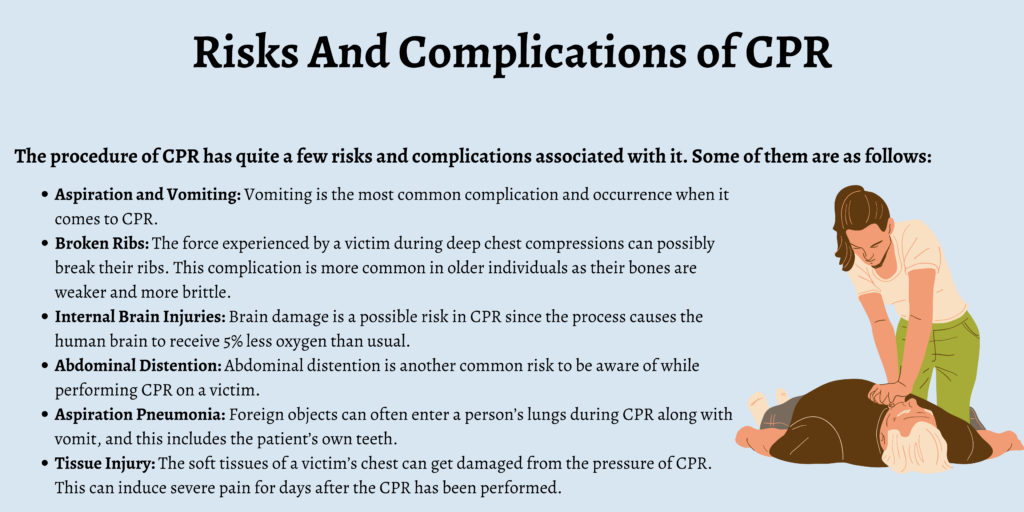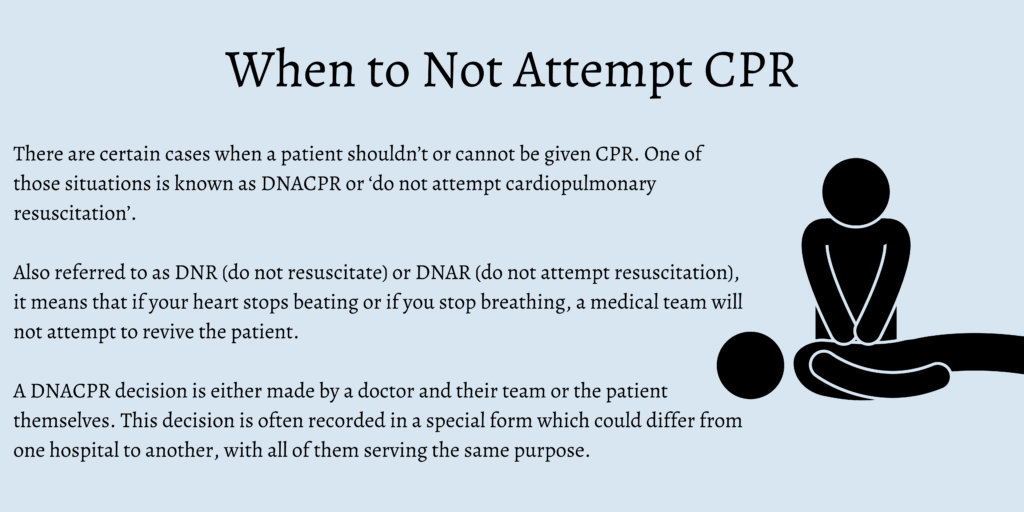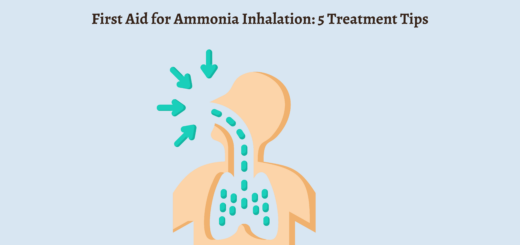Complications of Cardiopulmonary Resuscitation (CPR)
Cardiopulmonary resuscitation or CPR refers to an emergency treatment administered when a person stops breathing, or their heart stops beating.
As per a study by the American Heart Association, the out-of-hospital cardiac arrests taking place at home come up to 88%. Since there aren’t any nurses or medical professionals present in such cases, it becomes imperative for the people around the victim to know how to perform CPR.
The CPR must be continued until the victim regains spontaneous circulation. A victim’s chances of surviving an out-of-hospital cardiac arrest triple when a bystander is skilled at CPR.
However, there are a couple of complications associated with the medical intervention that is CPR, and it’s necessary to be aware of those while performing it on a patient. In this article, we will discuss those complications, when to not attempt CPR, etc.
Risks And Complications of CPR
The procedure of CPR has quite a few risks and complications associated with it. Some of them are as follows:
Aspiration and Vomiting
Vomiting is the most common complication and occurrence when it comes to CPR. This can be quite dangerous to the victim’s life since they cannot clear the vomit from their mouth as a result of being unconscious.
If not wiped away on time, the victim can inhale or aspirate it into their lungs, which can block their airway and cause infections.
Broken Ribs
The force experienced by a victim during deep chest compressions can possibly break their ribs. This complication is more common in older individuals as their bones are weaker and more brittle.
Broken ribs can also present the possibility of the patient having their liver, spleen, or lungs punctured. However, this risk can be avoided when the correct hand position is used.
Internal Brain Injuries
Brain damage is a possible risk in CPR since the process causes the human brain to receive 5% less oxygen than usual. It can take place about four to six minutes of the brain being deprived of oxygen and is sure to happen 10 minutes after the oxygen supply to the brain gets affected.
Internal brain injuries can cause long-term health issues for the patient.
Abdominal Distention
Abdominal distention is another common risk to be aware of while performing CPR on a victim. When air is forced into a patient’s lungs, their abdomen becomes bloated and full of air during the CPR process. This causes the lungs to compress, making the process of ventilation difficult and increasing the chances of vomiting.
Aspiration Pneumonia
Foreign objects can often enter a person’s lungs during CPR along with vomit, and this includes the patient’s own teeth. As a result of this, they can experience the side effect known as aspiration pneumonia.
Not only can this make the recovery process more complicated, but it can also pose a risk to the victim’s life.
Tissue Injury
The soft tissues of a victim’s chest can get damaged from the pressure of CPR. This can induce severe pain for days after the CPR has been performed. However, since force is imperative in CPR, there is not much that can be done to prevent this.
Do Cardiac Arrest Survivors Get Back to Normal After CPR?
Most of the cardiac arrests that take place outside of a hospital result in the victim not surviving post the incident. If a patient has several other health issues, the chances of them surviving dwindle even further.
Patients who receive CPR often need further treatment at an intensive care unit to promote full recovery. After being discharged from the medical facility, several patients experience restricted mobility, cognitive impairment, restricted societal participation, and depression post CPR.
In some cases, a patient could survive the CPR, but they never completely return to their previous healthy state both physically and mentally. Due to this, many of them are sent to a rehabilitation center.
Certain studies have reported better results once a patient goes through proper therapy. However, this isn’t always the case, and some patients also slip into a coma or experience brain damage, both of which are instances that the respective individuals never recover from.
When to Not Attempt CPR
There are certain cases when a patient shouldn’t or cannot be given CPR. One of those situations is known as DNACPR or ‘do not attempt cardiopulmonary resuscitation’.
Also referred to as DNR (do not resuscitate) or DNAR (do not attempt resuscitation), it means that if your heart stops beating or if you stop breathing, a medical team will not attempt to revive the patient.
A DNACPR decision is either made by a doctor and their team or the patient themselves. This decision is often recorded in a special form which could differ from one hospital to another, with all of them serving the same purpose.
These forms are easily recognized by doctors and all types of healthcare workers in emergency cases. They remain a part of a patient’s medical records and can also be kept in the patient’s home or care home.
The decision to refuse CPR can be taken by an individual at any given time, whether they’re healthy or have any existing medical conditions.
If a person wishes to make their DNACPR legally binding for a situation when they may not be able to firmly state or make this decision, they can go for an Advance Decision to Refuse Treatment (ADRT). This refers to a patient’s decision to refuse CPR or other medical treatments.
A person can change their DNACPR decision whenever they wish to. Inform your doctor that your DNACPR is not valid anymore. The form will remain as a part of your medical records so that your doctor can access any related conversations that took place regarding your decision in the past.
A DNACPR decision can also be taken by your doctor, even if your decision states otherwise. This is done by them when they believe that performing CPR will harm you physically or psychologically.
The law doesn’t require a patient’s consent for DNACPR if their doctor believes that CPR will not help them. The patients are, however, involved in the decision-making process where a DNACPR is concerned.
Once a doctor makes a DNACPR decision, they inform the patient so as to walk them through the whole process. This involves informing them what a DNACPR is and why the doctor decided so. They are consulted and asked about their preferences before the doctor takes the final call.
Conclusion
Even though there are complications and side effects associated with CPR, it can help in saving someone’s life in dangerous situations. A patient’s basic health condition cannot be treated through CPR, and it’s often the first step involved in a long journey toward recovery.
Recovering after receiving CPR is not easy, and a person’s life could totally get altered after this incident and procedure. Therefore, it’s vital to know about all the possible complications before performing CPR on a patient.
FAQs
1. When is CPR needed?
CPR is needed when a patient stops breathing, or their heart stops breathing.
2. What are some of the complications associated with CPR?
Some of the complications associated with CPR include tissue injury, brain damage, aspiration pneumonia, abdominal distention, aspiration and vomiting, and broken ribs.
3. Do patients go back to their normal state after CPR?
Not every patient reverts to their normal state after CPR, especially the ones who experience a cardiac arrest outside of a hospital.
4.Can the patient choose not to opt for CPR?
Yes, a patient can choose to not opt for CPR through a DNACPR form.
Can a doctor decide not to give CPR to a patient?
Yes, a doctor can decide to not give CPR to a patient if the situation calls for it.







